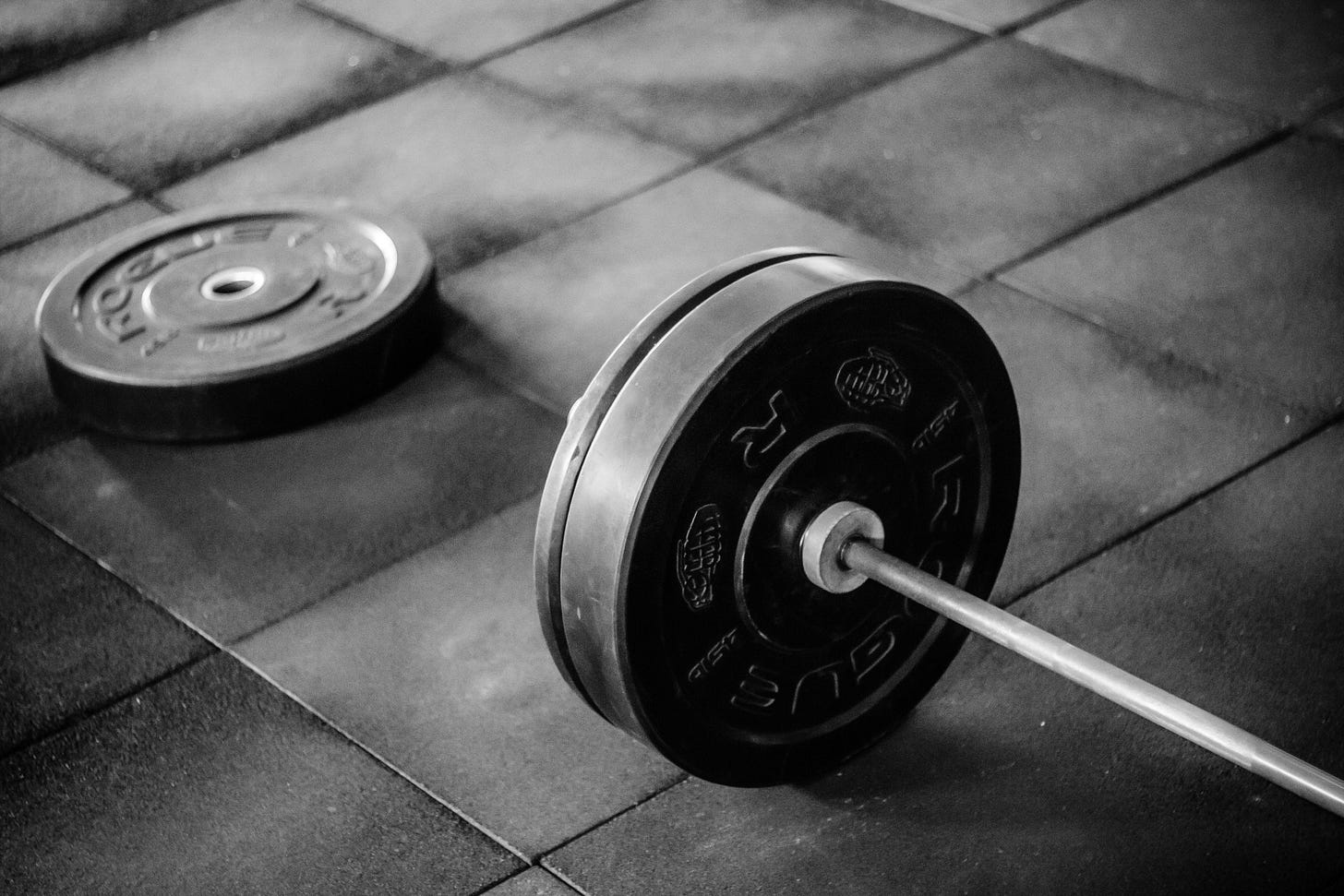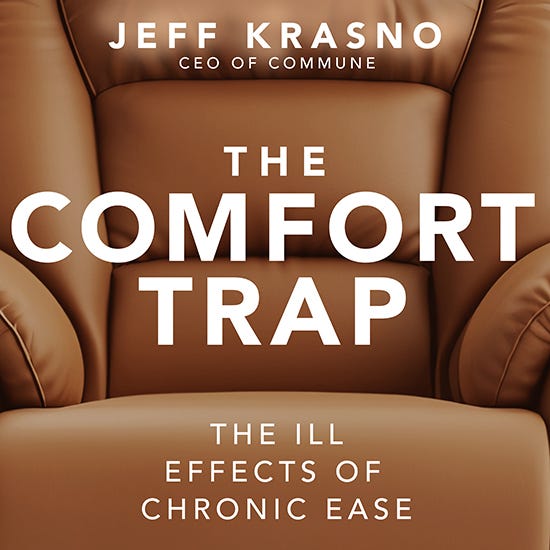Today’s installment of my special Substack series is part of a project titled The Comfort Trap: The Ill Effects of Chronic Ease. In this undertaking, I explore a profound yet oft-overlooked paradox of modern life: our relentless pursuit of ease is leading to an epidemic of chronic disease.
Across the adventure, I leverage my mythical hunter-gatherer ancestor Ffej Onsark (yes, my name spelled backwards) as the benchmark for comparing ancient and modern living conditions.
The comparison elucidates modernity’s comfort-induced evolutionary mismatches and their many negative knock-on physiological and psychological impacts.
In you find today’s excerpt interesting, you can dive deeper on Substack. If you prefer the lilt of my voice, you can listen on the Commune podcast or purchase the entire effort on Audible, Apple Books, or Spotify.
In love, include me,
Jeff
Old Ffej didn’t have an Equinox membership or a Peloton bicycle. Nor did he consider physical activity a choice. Moving his body in the great outdoors was as much a part of the biological imperative to survive as eating and sleeping. Ffej’s quotidian life was a mix of what we might call today aerobic exercise, strength training, and HIIT (high-intensity interval training).
On an average day, Ffej walked 10 miles per day in search of food. The Hadza people of Tanzania, who are among the few remaining hunter-gatherer populations in the world, still walk 7 miles per day in pursuit of daily provisions. The same is true for the !Kung people of the Kalahari Desert in southern Africa. For those who are counting on their iWatch, this would equate to approximately 14,000 daily steps.
While Ffej didn’t curl 20-pound dumbbells in front of a full-length mirror, he did climb trees, lug firewood, and build structures. He hunted, fished, and foraged. He crafted tools and shelter. And, at night, if inspired, he might break out in a furious jig around the campfire. Less jolly, from time to time, a predator might press Ffej into an involuntary life-preserving sprint which would today qualify as high-intensity interval training.
By mere dint of his lifestyle, Ffej burned between 2,500 and 4,000 calories per day. His quotidian activity in combination with his nutrient-dense and protein-rich diet informed his lithe but sinewy physique.
The chopping wood and carrying water of regular everyday life conferred many benefits, including superlative cardiovascular health. In fact, in Ffej’s era, heart disease was essentially non-existent, as were diabetes and dementia.
Fast forward to today, and cardiovascular disease is the world’s number one assassin. On average, approximately 1900 Americans die every day from a faulty ticker. One of the contributing factors to the development of vascular disease is, of course, physical inactivity and sedentariness. According to the CDC, approximately 80% of US adults are not meeting the federal guidelines for both aerobic and muscle-strengthening activity. The key CDC guidelines for adults include at least 150 minutes a week of moderate-intensity or 75 minutes a week of vigorous-intensity aerobic physical activity. In addition, adults should also do muscle-strengthening activities of moderate or greater intensity that involve all major muscle groups on 2 or more days a week. These guidelines are not particularly onerous – think Ffej, cavebound on the darkest, coldest week of the year. And yet only one in five Americans manages to hit the mark.
According to recent studies, the average American takes just 3,000 steps per day. This reduction in physical activity coincides with technological innovations that were intended to make life easier and more convenient, compounding the dis-eases of ease.
How Did We Get Here?
The first significant shift from a life of movement to a life of convenience began with the Agricultural Revolution about 12,000 years ago. This cultural upheaval reduced nomadism, allowing humans to settle, farm, and domesticate animals. It could be argued that humans were really domesticating themselves.
The etymology of domesticate is domesticus – Latin for “belonging to the house.” While Ffej and his tribe regularly migrated across the savannah in search of food, his great-great-grandchildren increasingly “belonged to the house.”
Still, early agrarians expended vast amounts of energy—plowing fields, harvesting crops, and herding sheep and goats —activities that still required considerable physical exertion. The early farmers of Mesopotamia milked aurochs, a type of cattle. Have you ever milked a cow? It’s quite arduous and requires both endurance and a sense of rhythm. Of course, cows on today’s factory farms are not milked manually, so I won’t be utterly surprised if you’ve never handled a cow teat.
The real tipping point toward sedentariness came with the Industrial Revolution in the late 18th century.
No longer toiling in the fields, urbanized workers began spending long hours on factory lines, standing or sitting in one place. The earliest factories were textile mills. Ffej’s descendants might have toiled in Richard Arkwright's cotton mill, one of the most famous early factories, located in Derbyshire, England, and established in 1771. Arkwright's mill used water-powered spinning frames, marking the beginning of large-scale mechanized textile production. The factory system allowed for continuous production, significantly increasing output and reducing costs. While this was still physically demanding work, it reflected the beginning of a lifestyle shift where activity became less varied and more monotonous.
Of course, all of this extensive output at the cotton mill required careful accounting. Thus, Arkwright needed to hire a team of administrators to manage inventory, track expenses, and monitor profits and losses. The rise of clerical and administrative jobs created a workforce that spent most of the day sitting across a standardized 9-5 workday, marking a significant transformation from physically active agricultural work.
According to the Bureau of Labor Statistics, by 2020, 80% of U.S. jobs were classified as service-oriented, with most of these being desk jobs in fields such as administration, sales, and IT.
At quitting time, Industrial cogs-in-the-machine would clock out and head home. But there was increasingly less need to walk. The Industrial Revolution also witnessed the invention of the steam engine. Steam-powered locomotives reduced the need for old-fashioned human locomotion. The first practical steam locomotive, developed by George Stephenson in the early 1800s, obviated the need for people to walk long distances between towns and cities.
Step counts were further reduced by the rise of automobiles in the 20th century. The first Model T, produced by the Ford Motor Company in 1908, was priced at about $850, which is equivalent to roughly $25,000 today when adjusted for inflation. As production methods improved and Ford introduced the assembly line in 1913, the cost of the Model T decreased dramatically, dropping to as low as $260 in 1925.
What once required walking or cycling has now become a short drive. Suburbanization further exacerbated this trend, as people moved to neighborhoods where walking was impractical, and driving became a necessity. In 1947, William Levitt and his sons developed Levittown, one of the first mass-produced suburbs on Long Island. It was designed to offer affordable housing to returning veterans through the GI Bill, which provided low-interest loans. The efflorescence of hamlets like Levittown represented a shift from urban living to sub-urban communities, characterized by single-family homes, manicured lawns, picket fences, and the ideal of the "American Dream."
Families moved to areas like Levittown, seeking space, safety, and comfort. However, suburbanization also led to a reliance on automobiles and a shift away from walking-centric urban lifestyles. In Levittown and other suburbs, homes were often far from workplaces, shopping centers, and recreational areas, which made car ownership a necessity.
Sedentary living was further accelerated by the digital revolution. Home entertainment in the form of television, video games, computers and smartphones embedded modern humans deeper inside the house. Denizens of the West now spend 94% of their day indoors. The concept of “binge-watching” entire seasons of a show has become a cultural norm, pushing us further into the depths of inactivity. Teens in the United States spend an average of 8 hours and 39 minutes per day staring into the glow of screens.
The convenience of pre-packaged and microwaveable meals further reduced the need for physical activity in food preparation. And today, we need not even leave the easy chair to summon food. From myriad apps, we can order Big Macs, Chick-fil-A, and virtually any other type of food.
Even modernity’s educational and social structures favor inactivity. Traditional classroom settings prioritize seated learning, with students sitting for long periods with minimal physical activity. In many educational systems, physical education has been de-emphasized, contributing to torpid habits from a young age. Social activities increasingly revolve around dining out, watching movies, or engaging in online interactions.
Again, we witness how our insatiable appetite for convenience and comfort upends our evolutionary wiring. We were designed to move. And, in the absence of movement, we’ve gotten soft in body and mind. We’ve been snared by the comfort trap.
What Happens When We Stop Moving: A Little Science
Sedentary living contributes directly to virtually all of our most widespread chronic diseases. It results in poor heart health, imbalanced glucose levels and neurodegenerative disease. It leads to muscle loss known as sarcopenia in older adults and is highly correlated with mortality in connection with falls and broken hips.
And, of course, indolent behavior sponsors obesity. This may seem instinctual – but let me explain how this works.
Weight management is an “exercise” in energy equilibrium. Maintaining a healthy weight involves balancing energy consumed, energy expended, and energy stored.
Humans stockpile energy as fat. In the section on food, I described how storing fat is adaptive – but just not ALL the time. Humans were engineered to get a little fat in the late summer and autumn as a bulwark against winter’s fallow. Fat is a villain in today’s social media culture, but up until the early 20th century, extra weight on women was a marker of beauty and fertility, and for men, bulk meant power. But regardless of the vagarities of beauty culture, fat is nothing more than warehoused energy.
We simply want to adaptively manage the size of our fat repository. And one way to do this is through regular movement and exercise.
Exercise is a fundamental component of weight management through various physiological mechanisms. One of the most direct ways exercise helps with weight management is by burning calories. The more intense and prolonged the activity, the more calories are burned.
You may be familiar with the theory of weight management known as “calories in / calories out.” But what is a calorie?
A calorie is a relatively bizarre and arcane measurement for a unit of energy. In the context of nutrition and exercise, when people refer to "calories," they're actually referring to kilocalories (Kcal). A kilocalorie is the amount of heat required to raise the temperature of one kilogram of water by one degree Celsius.
Humans get calories from consuming macronutrients in their diet. Carbohydrates provide 4 calories per gram, protein provides 4 calories per gram and fat provides 9 calories per gram. And I’ll add, somewhat wistfully, alcohol, which provides 7 “empty” calories.
So, what is the association between calories and weight management? In order to understand the connection, we need to review the basic laws of thermodynamics.
The First Law of Thermodynamics, also known as the law of conservation of energy, states that energy cannot be created or destroyed, only transferred or converted from one form to another. In terms of calories and human metabolism, this law underlies the concept of energy balance. The calories we consume from food provide us with energy. This energy is either used by the body for activities and bodily functions or stored in the body, mostly as fat. If you consume more calories than your body uses, you will gain weight. If you consume fewer calories than your body uses, you will lose weight.
The Second Law of Thermodynamics states that in any energy transfer or transformation, some amount of energy is lost as heat. In biological systems, this means that not all energy (calories) consumed can be perfectly converted into work or stored energy. Some of the energy is lost as heat during metabolic processes. This is the reason why the body has a basal metabolic rate, which is the minimum amount of energy required to keep the body functioning at rest. This energy is largely used for maintaining body temperature.
In other words, you burn about one calorie per minute lounging on the couch watching Curb Your Enthusiasm or sitting at your desk typing gossipy emails because your body is maintaining body temperature, digestion, and other basic processes. That totals 1,440 calories burned per day … just staying alive.
Alternately, you burn about 100 calories walking a mile at a leisurely pace (about 3 miles per hour). Given Ffej walked on average 10 miles per day, he burned 1000 calories by mere dint of his daily perambulation.
Generally, the recommended daily calorie intake is 2,000 calories a day for women and 2,500 for men. But, of course, this totally depends on other variables, including physical activity. Despite these recommendations, according to the United Nations Food and Agriculture Organization's latest annual statistics report, the ever-expanding denizens of Europe and North America consumed on average 3,540 calories per day.
Given this, you can very easily see how the elixir of modern sedentariness and over-consumption quickly leads to obesity. The general rule is that 3,500 excess calories will lead to the gain of one pound of fat. So, if your consumption outpaces your burn by 500 calories per day, you will gain a pound of fat every week.
In my book Good Stress, I delve into the subtleties of how not all calories are created equal. That said, the laws of thermodynamics undeniably apply to weight management. If you don’t burn it, you’re going to store it. Hence, the more we sit around and expend minimal energy, the more fat remains warehoused. An excess of fat taxes the heart. As fat cells grow and become hypoxic, they release inflammatory adipokines that can contribute to atherosclerosis.
There are other ways that exercise impacts weight. For example, strength training increases muscle mass. Muscle tissue burns more calories at rest compared to fat tissue. Thus, having a higher muscle-to-fat ratio can boost the body's basal metabolic rate, leading to more calories being burned throughout the day, even when checking Instagram. Muscle is also a natural glucose sink, and the contraction of muscle will uptake glucose from the bloodstream without insulin. Exercise also regulates appetite, relieves stress, and improves sleep – all of which can impact metabolic health and weight management.
Living More Like Ffej
In my book Good Stress, I outline an exercise protocol that mirrors our ancestral patterns. This regimen included resistance training, aerobic training, and flexibility training. I get into the optimal mix of Zone 2 and Zone 5 training and the nuances of muscle hypertrophy. While there’s utility in breaking down the components of exercises, there’s a broader point to make.
I was always a regular exerciser, even in my more slothful adolescence. However, like many folks, I exercised largely out of guilt. The gym was a form of penance. I was a sinner, huffing and puffing my Hail Marys to atone for my over-indulgences. I believed that I could set things right by panting on the treadmill for an hour. I now call this misguided approach to exercise “chronic cardio.” It’s not that aerobic exercise is bad. But, on its own, without other forms of exercise and a focus on eating habits, it will never yield the desired results.
Furthermore, like so many others, I productized exercise. It became another bullet on my to-do list. After 8 hours of sitting, staring into a screen, I’d haul myself to the gym for an hour. This tendency to cubby hole exercise as a discreet event instead of integrating movement organically into our lives doesn’t work. We’ve seen a massive efflorescence of gyms in the United States over the last 50 years. But despite currently having over 45,000 dedicated places to sweat and grunt, obesity rates have tripled since the mid-70’s.
While the particulars of aerobic and resistance training are important, the first key to health is changing our basic understanding of exercise and our relationship to movement.
We can’t treat exercise as an isolated daily event. To live more like Ffej, we must move throughout the day. Modern medicine has given this concept a fancy rubric: N.E.A.T. This acronym stands for Non-exercise activity thermogenesis. N.E.A.T. includes all the energy expenditures across the course of your day, from taking the stairs to doing household chores to rucking your groceries. Movement as a way of life has immeasurable benefits. To realign with our biology, we must stop seeing exercise as a chore and start making movement a natural part of our day.
Today’s newsletter features an excerpt from my audio program, The Comfort Trap: The Ill Effects of Chronic Ease.
Available for purchase on Audible or stream it for free with your Spotify Premium subscription.









As always, thank you for your thoughts. I a reminded of the caterpillar who has to struggle before becoming a butterfly. I am now going to move more. I have learned to make movement part of my life, rather than going to a gym.
thanks, Ffej
your words have inspired me to get off my ass and perambulate